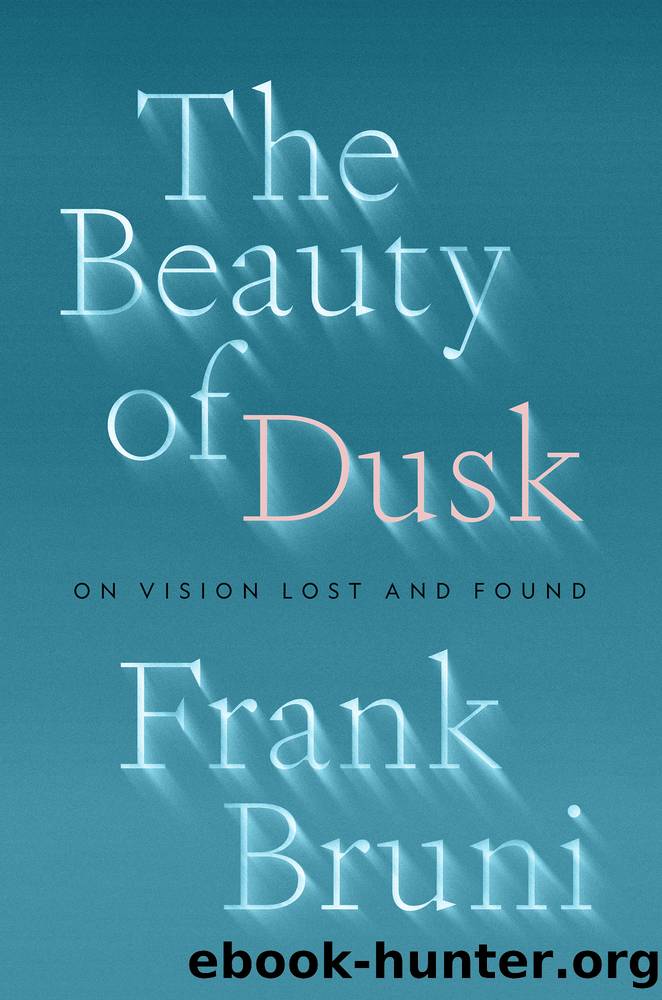The Beauty of Dusk by Frank Bruni

Author:Frank Bruni
Language: eng
Format: epub
Publisher: Avid Reader Press / Simon & Schuster
Published: 2022-03-02T00:00:00+00:00
* * *
I became a connoisseur of the unlikely accomplishments of blind peopleâunlikely in the eyes (forgive me) of people inattentive to the starfish in all of us, by which I mean people like me before my stroke. Without going in search of such feats, I spotted mentions of them here, there and everywhere: the blind dancer, the blind painter, the blind gallerist. I tripped across the name of the mountain climber and adventurer Erik Weihenmayer, who became the first blind person to reach the summit of Mount Everest, then completed ascents of all seven of the worldâs highest peaks and, for good measure, kayaked the roiling rapids in the Grand Canyon. That information had no doubt been around me all along, but I had been too distracted, too innocent, too smug to pick up on it.
A little more than a year after the damage to my right eye, on a segment of the popular television news show 60 Minutes, Lesley Stahl told the story of a San Francisco architect, Chris Downey, who went blind at the age of forty-five following the removal of a brain tumor that was pressing on his optic nerves. The surgery had carried that risk, and Downey had been informed of it, but he had also been told that such an outcome never really, truly, actually came to pass. With him it did.
Downeyâs version of blindness, an extreme one, was total darkness, and a social worker who counseled him suggested that they discuss career alternatives. But he wanted the career he already hadâand felt, deep inside, that he could hold on to it if he were determined and creative enough. Yes, his eyes had failed, but his mind hadnât, and didnât that matter more?
âThe creative process is an intellectual process,â Downey told Stahl. âItâs how you think. I just needed new tools.â
Walking through buildings and under roofs that he knew, visually, from before his blindness, he came to understand how soundsâof his own movement, of his caneâs tapping, of other peopleâs voices and stepsâtraced the contours of a structure, and that enabled him to turn such auditory clues from unfamiliar structures into knowledge, or at least educated assumptions, about how they were shaped and what they must look like.
âI was hearing the architecture,â he told Stahl. âI was feeling the space.â
As for drawing and reading construction plans and room layouts, he could do that by using a printer that turned lines into ridges: architectural braille, as it were. âThey just came out in tactile form,â he explained. As a result, he didnât consider what he was experiencing blindness per se. He described it to Stahl as âa different kind of vision.â
For people with seriously compromised eyesight, there are many different kinds of vision, and all of them speak to the real center of perception and to its deftness at filling in sensory blanks.
âYou donât see with the eyes, you see with the brain,â Paul Bach-y-Rita, a renowned American neuroscientist who was known as âthe father of sensory substitution,â once said.
Download
This site does not store any files on its server. We only index and link to content provided by other sites. Please contact the content providers to delete copyright contents if any and email us, we'll remove relevant links or contents immediately.
Machine Learning at Scale with H2O by Gregory Keys | David Whiting(4183)
Never by Ken Follett(3794)
Harry Potter and the Goblet Of Fire by J.K. Rowling(3775)
Unfinished: A Memoir by Priyanka Chopra Jonas(3333)
Fairy Tale by Stephen King(3220)
The Man Who Died Twice by Richard Osman(2997)
Will by Will Smith(2793)
Rationality by Steven Pinker(2291)
The Dark Hours by Michael Connelly(2245)
Can't Hurt Me: Master Your Mind and Defy the Odds - Clean Edition by David Goggins(2228)
It Starts With Us (It Ends with Us #2) by Colleen Hoover(2198)
The Storyteller by Dave Grohl(2172)
The Dawn of Everything: A New History of Humanity by David Graeber & David Wengrow(2122)
Friends, Lovers, and the Big Terrible Thing by Matthew Perry(2119)
The Becoming by Nora Roberts(2088)
The Stranger in the Lifeboat by Mitch Albom(2050)
Cloud Cuckoo Land by Anthony Doerr(2035)
Einstein: His Life and Universe by Walter Isaacson(1967)
Love on the Brain by Ali Hazelwood(1965)
